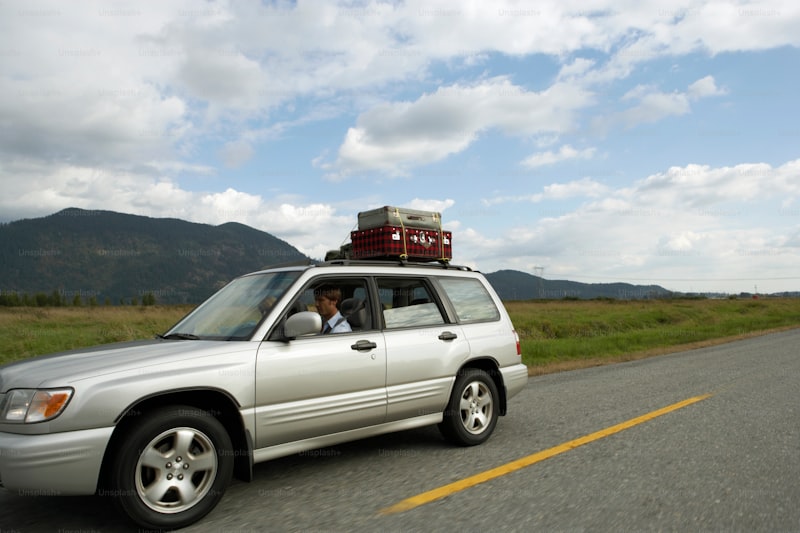First things first, start with the basics. Check your oil levels and top up if needed. Think of oil as your car’s lifeblood—it keeps everything running smoothly. Next, inspect your tires. Are they properly inflated and in good condition? A quick tire check can prevent blowouts and ensure better fuel efficiency.
Brakes are crucial for safety. Test them out before you go—listen for any unusual sounds or grinding sensations. Brake pads and fluid should be in good shape for optimal performance.
Lights and signals are often overlooked but are essential for visibility. Are all your lights working? Replace any bulbs that are out and clean foggy lenses for maximum brightness.
Fluids keep your car running smoothly. Check coolant levels to prevent overheating, especially in hot weather. Windshield washer fluid ensures clear visibility. Don’t forget about steering fluid and transmission fluid—both critical for a responsive and smooth drive.
Pack smartly for comfort and safety. Essentials like a first aid kit, roadside emergency kit, and spare tire are must-haves. Consider extras like a portable charger for devices and a map or GPS for navigation.
Lastly, think about your car’s comfort too. Clean out clutter to create space and reduce weight for better fuel efficiency. Keep essentials like snacks and water within reach.
Expert Tips: Essential Checks to Prep Your Car for Your Next Road Adventure
Firstly, start with your tires. They are your car’s connection to the road, so check for adequate tread depth and ensure they are properly inflated. Proper tire pressure not only improves fuel efficiency but also enhances safety and handling, especially on long drives through varying road conditions.
Next, inspect your vehicle’s fluids. Top off the engine oil to the recommended level and check the transmission, brake, and coolant fluids. Fluid levels play a critical role in your car’s performance and longevity, so ensuring they are at optimal levels is key.
Check your brakes thoroughly. Brake pads should be thick enough, and the brake fluid level should be within the recommended range. Proper braking capability is essential for safe driving, particularly when navigating through different terrains or encountering unexpected road conditions.
Don’t forget about your lights and signals. Ensure all headlights, brake lights, turn signals, and hazard lights are functioning correctly. Properly working lights not only keep you visible to other drivers but also ensure you can see the road ahead clearly, especially during night driving or inclement weather.
Inspect your battery to ensure it’s in good condition. Clean any corrosion on the terminals and check the battery’s charge level. A reliable battery is crucial for starting your car reliably and powering essential electronics throughout your journey.
Lastly, examine your wiper blades and windshield washer fluid. Clear visibility is essential, so replace worn-out wiper blades and ensure your windshield washer reservoir is filled. This preparation is particularly crucial for driving in rainy or snowy conditions.
By following these expert tips and conducting these essential checks, you can significantly reduce the risk of breakdowns and ensure a safe and enjoyable road adventure. Prepare your car thoroughly, and you’ll be ready to embark on your journey with confidence.
Road Trip Ready: Top 10 Maintenance Must-Dos for Your Vehicle
Firstly, check your tires. Ensure they are properly inflated and have sufficient tread depth to handle varying road conditions. Well-maintained tires not only improve fuel efficiency but also enhance safety.
Next, inspect the brakes. Brakes should be responsive and free of any unusual noises or vibrations. If you notice any issues, it’s essential to have them inspected and serviced by a professional.
Don’t forget about your fluids. Check engine oil, transmission fluid, coolant, brake fluid, and windshield washer fluid levels regularly. Keeping these fluids topped up helps prevent engine overheating and ensures optimal performance.
Inspect your battery. Ensure terminals are clean and securely connected. A weak battery can leave you stranded, especially in cold weather. Consider having it tested if it’s more than three years old.
Lights and signals should be in working order. Test headlights, taillights, brake lights, and turn signals to ensure visibility and safety on the road, day or night.
Replace worn-out wiper blades. Clear visibility is crucial, especially during inclement weather. Replace blades that streak or leave behind residue for a clearer view.
Check the air conditioning system. A comfortable cabin temperature makes long drives more enjoyable. Ensure the AC system blows cold air and consider having it serviced if necessary.
Inspect the belts and hoses under the hood. Look for signs of wear, cracks, or fraying. These components are critical for engine operation and should be replaced if damaged.
Ensure your spare tire is in good condition and properly inflated. It should be ready to replace a flat tire in case of emergencies.
Lastly, pack an emergency kit. Include essentials like a flashlight, first aid supplies, jumper cables, and basic tools. Being prepared can make a significant difference in unexpected situations.
Ensure a Smooth Journey: The Ultimate Guide to Preparing Your Car for a Road Trip
Firstly, check your tires. They’re your car’s shoes on the road, so ensuring they’re in top condition is non-negotiable. Look for signs of wear and tear, and make sure the tire pressure is optimal according to your vehicle’s specifications. Properly inflated tires not only improve fuel efficiency but also enhance safety on the road.
Next, inspect your brakes. Squeaky brakes or a mushy pedal are red flags that shouldn’t be ignored. Have a mechanic assess your brake pads and rotors to ensure they’re in good shape. Responsive brakes are critical for maintaining control, especially during unexpected stops or emergency situations.
Fluid levels are another essential checkpoint. Check your engine oil, transmission fluid, brake fluid, and coolant levels. These fluids lubricate, clean, and cool various components of your car’s engine, ensuring it runs smoothly throughout your journey.
Don’t overlook your car’s lights and signals. Ensure all headlights, taillights, brake lights, and turn signals are functioning correctly. Proper lighting not only keeps you visible to other drivers but also helps you see the road clearly, especially during nighttime driving.
Furthermore, inspect your battery. A weak or old battery can leave you stranded, so check its condition and connections. Clean off any corrosion on the terminals and consider having a professional test its performance if it’s been a while since your last inspection.
Lastly, pack an emergency kit. Include essentials like a first-aid kit, flashlight, spare tire, jack, and jumper cables. Being prepared for unforeseen circumstances can make all the difference in quickly resolving issues and getting back on track with your trip.
Step-by-Step Car Care: Getting Your Vehicle Ready for Long-Distance Travel
Firstly, start with the basics: check your tire pressure and tread depth. Properly inflated tires reduce fuel consumption and ensure better traction, especially on long journeys where road conditions can vary. Inspect each tire for any signs of wear and tear, and replace them if necessary to avoid potential blowouts.
Next, examine your vehicle’s fluid levels. This includes engine oil, coolant, brake fluid, and windshield washer fluid. Each of these fluids plays a crucial role in maintaining the optimal performance of your car. Ensure they are topped up to the recommended levels, and consider having an oil change if you’re nearing the mileage limit recommended by your manufacturer.
Inspect your car’s brakes to ensure they are in good working order. Spongy brakes or unusual noises when braking could indicate worn brake pads or other issues that need attention. Properly functioning brakes are essential for your safety and the safety of others on the road.
Check all exterior lights, including headlights, brake lights, turn signals, and hazard lights. Replace any bulbs that are burnt out and ensure all lights are clean for maximum visibility, especially during nighttime driving or adverse weather conditions.
Clean both the interior and exterior of your car thoroughly. A clean car not only looks good but also helps prevent rust and corrosion. Pay attention to the windshield and windows, ensuring they are free of dirt and streaks that could impair your visibility.
Lastly, pack an emergency kit that includes essentials such as a flashlight, first aid supplies, blankets, water, and non-perishable snacks. Being prepared for unexpected situations can make a significant difference during long-distance travel.
Safety First: Preparing Your Car for a Road Trip Without Missing a Detail
First things first, let’s talk tires. Your tires are literally where the rubber meets the road, so checking their condition is crucial. Are they properly inflated? Is the tread depth sufficient to handle varying road conditions? A quick inspection can save you from the headache of a blowout halfway to your destination.
Next up, fluids. Think of your car’s fluids like the lifeblood of your engine. Check your oil levels and ensure they’re at the recommended mark. Don’t forget about coolant, brake fluid, and windshield washer fluid—each plays a vital role in keeping your car running smoothly. It’s a small detail that can prevent major headaches down the road.

Brakes are another critical component often overlooked until it’s too late. Do a visual inspection of your brake pads and discs. Are they worn out? Squeaky? Grinding noises when you brake are a definite red flag—it might be time for a replacement.
Lights and signals are not just for decoration—they’re your communication with other drivers. Test all your lights—headlights, brake lights, turn signals, and hazard lights. A burnt-out bulb might seem minor, but it could lead to a serious accident if others can’t see your intentions.
Lastly, pack an emergency kit. It’s like insurance—it’s better to have it and not need it than the other way around. Include items like a flashlight, jumper cables, a first aid kit, and basic tools. You never know when they might come in handy.
From Tires to Tech: Complete Checklist for Preparing Your Vehicle for Road Trips
Firstly, your tires are your ride’s foundation. Imagine them as the sturdy shoes of your car, connecting you to the road. Check the tire pressure and tread depth to ensure optimal grip and stability. Properly inflated tires not only enhance safety but also improve fuel efficiency, saving you money along the way.
Next up, fluids are the lifeblood of your vehicle. Before embarking on your adventure, check the oil level and quality. Clean oil keeps your engine running smoothly, preventing overheating and wear. Don’t forget about coolant, brake fluid, and windshield washer fluid. Each serves a vital role in keeping your car operating at its best under various conditions.
Lights and signals are crucial for communication on the road. Check that all exterior lights are working – headlights, brake lights, turn signals, and hazard lights. These not only keep you safe but also ensure you’re visible to other drivers, especially during nighttime or adverse weather.
Brakes are your best friends when it comes to safety. Have them inspected to ensure they’re responsive and reliable. Squeaky brakes or a soft pedal could indicate worn pads or low brake fluid levels, which need immediate attention before you set off.
Now, let’s talk about technology. In today’s digital age, your vehicle is likely equipped with various tech gadgets. Ensure your GPS or navigation system is up-to-date with maps and traffic information. Pack chargers for your devices, so you’re always connected and entertained throughout the journey.

Lastly, pack an emergency kit for unexpected situations. Include essentials like a first aid kit, flashlight, blankets, and non-perishable snacks. You never know when you might need them, and being prepared can make all the difference.
DIY Car Care: Easy Steps to Make Your Vehicle Road Trip-Ready
Thinking about hitting the road for an exciting adventure? Before you rev up your engine, it’s essential to ensure your car is in top shape for the journey ahead. DIY car care isn’t just about maintenance; it’s about peace of mind, knowing your vehicle can handle whatever the road throws at it. Whether you’re planning a cross-country expedition or a weekend getaway, these easy steps will help make your vehicle road trip-ready without breaking a sweat.
First things first, let’s talk tires. Your tires are the foundation of a smooth ride, so start by checking the tire pressure and tread depth. Properly inflated tires not only improve fuel efficiency but also enhance stability and safety. Use a pressure gauge to ensure they’re within the recommended range – it’s like giving your car a hug with each pound of air!
Next up, give your car’s heart – the engine – some love. Check the oil level and condition. Clean oil keeps your engine running smoothly and can prevent costly repairs down the road. Don’t forget to inspect other vital fluids like coolant, brake fluid, and windshield washer fluid. They may not be as glamorous as a new coat of paint, but they’re just as essential to keep things humming along.
Now, let’s shine a light on your lights. Headlights, brake lights, turn signals – they all play a crucial role in keeping you visible and safe on the road. Replace any bulbs that are burnt out and give the lenses a good clean. It’s amazing how much more you can see and be seen with a little TLC for your lights.
Bringing it all together, take a moment to inspect your brakes. Squeaking, grinding, or shaking when you press the pedal? Time to have them checked by a professional. Your brakes are your car’s best friend when it comes to stopping safely, so don’t ignore any warning signs.
Lastly, don’t forget the creature comforts. Clean out any clutter inside your car, vacuum the floors, and maybe even toss in a new air freshener for that extra dash of road trip ambiance.
By following these simple steps, you’ll be ready to hit the road with confidence, knowing your DIY car care has set you up for a smooth and enjoyable journey. So, what are you waiting for? Adventure awaits – it’s time to make memories on the open road!
Frequently Asked Questions
Should I inspect my brakes before going on a road trip?
Yes, inspecting your brakes before going on a road trip is crucial for your safety. Brakes should be checked to ensure they are functioning properly, with sufficient pad thickness and no signs of wear or damage. This helps prevent potential brake failures and ensures reliable stopping power during your journey.
What essential checks should I perform before a road trip
Discover essential checks to perform before embarking on a road trip to ensure a safe and smooth journey. Learn about vehicle maintenance, tire condition, fluid levels, emergency kit preparation, and route planning for a hassle-free travel experience.
How often should I check tire pressure and why is it important
Learn how frequently to check tire pressure and its crucial importance. Understand the optimal intervals for inspection to ensure safe driving conditions and extend tire lifespan.
How can I prepare my car’s fluids for a long journey
Learn how to prepare your car’s fluids for a long journey efficiently with our clear and concise guide. Ensure your vehicle’s optimal performance and longevity by following these essential steps.
What items should I include in a road trip emergency kit
Learn what essentials to pack in your road trip emergency kit. Ensure safety with items like a first aid kit, flashlight, jumper cables, tools, water, non-perishable snacks, blankets, and a fully charged phone.



